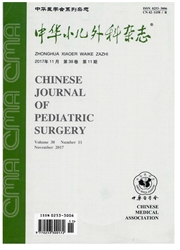

 中文摘要:
中文摘要:
目的定量观察支配肛提肌的感觉神经元,探讨先天性肛门直肠畸形术后发生排便功能障碍的病因。方法采用胎仔外科、显微注射和神经示踪相结合技术对孕20 d Wistar胎鼠支配肛提肌的感觉神经元进行荧光金标记,脊髓连续横切片,计数标记神经元数量并观察神经元形态。乙烯硫脲致畸制作先天性肛门直肠畸形动物模型。结果支配肛提肌的感觉神经元主要分布在L5-S1脊髓节段的脊髓背根神经节。正常对照组(24只胎鼠)标记神经元数量为(11804±2362)个,先天性肛门直肠畸形组标记神经元数量明显减少,低位畸形组(18只胎鼠)为(2886±705)个,高位畸形组(41只胎鼠)为(1026±425)个,两个畸形组分别与正常对照组相比差异有统计学意义(均P〈0.05)。结论先天性肛门直肠畸形胎鼠支配肛提肌腰骶髓感觉神经元存在明显发育异常。
 英文摘要:
英文摘要:
Objective To quantitatively observe the sensory neurons innervating the levator ani muscle and explore the cause of poor post-operative anorectal function in patients with anorectal malformation (ARM). Methods Combining the microsurgery and microinjection techniques, we investigated the deficiency of sensory neurons of the spinal cord in fetal rats with anorectal malformation by injecting the retrograde tracer ituorogold (FG) into the muscle levator ani. Sixty 11 days pregnant female rats were fed with ethylenethiourea (ETU) so as to cause ARM in the fetuses. When the female rats were 20 cays pregnant they underwent hysterectomy and the male fetal rats were taken out. Fluorogold ( FG), a tracer, was injected into their levator ani musclos. Then the fetal rats were put back into the uteri. Twenty-four hours later hysterectomy was performed for the second time to take out and kill the live fetuses that had undergone FG injection. Their lumbo-sacral spinal cords were taken out, fixed and made into serial longitudinal sections. Digital camera system and fluorescent microscopy were used to observe the FG-labeled sensory neurons. Fifteen normal female rats were used as controls. Results The FG-labeled sensory neurons innervating levator ani muscle were located mainly in the posterior root ganglia of the 5 th segment of lumber and the I st sacral cord. The number of FG-labeled sensory neurons in the normal control fetuses, fetuses without defect of the ETU-fed female rats, fetuses with low type imperforate anus, and fetuses with high type imperforate anus were 11 804 ±2362, 10 429 ±708, 2886 ±705, and 1026 ±425 respectively, the latter 2 number being significantly fewer than that in the fetuses without defects (P 〈 0. 05 ) and that in the normal controls (P 〈 0. 05 ). Conclusion Defective sensory neurons innervating the levator ani muscle co-exists with the alimentary tract anomaly in rat fetuses with ARM. The defective development of sensory neurons is an important factor likely to contr
 同期刊论文项目
同期刊论文项目
 同项目期刊论文
同项目期刊论文
 期刊信息
期刊信息
